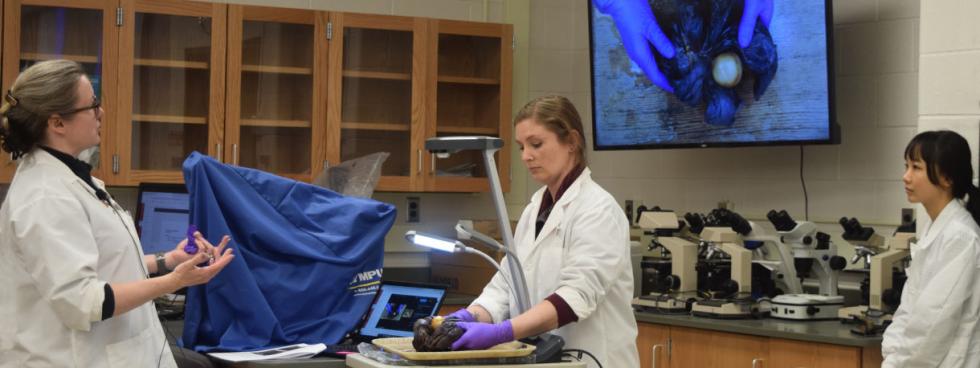
A New Normal
As Dr. Amanda Fales-Williams, professor of veterinary pathology and Tyrone D. Artz, MD Chair for Teaching Excellence, walks down the hall to the lecture room, the reality sets in. She’s taken aback by the lack of students in the hallway. But, the most jarring reality is the silence – in the hall and the building.
On a normal day, she and the first-year veterinary students wait in the hall outside the lecture room, while the noon hour class or club meeting finishes. While they wait, classmates are chatting with each other, going over notes, or texting messages. But not today. Today is the start of a new normal.
Last month, Iowa State University shifted all coursework online for the remainder of the spring semester in response to the COVID-19 global pandemic. Like many of her colleagues at the College of Veterinary Medicine, Fales-Williams spent spring break exploring ways to present their courses online.
For Fales-Williams, it’s a challenge she is ready to accept, but not without some trepidation.
“It could be a train wreck,” she says. “Technology is easier to use now," she says, "but I have to access several different aspects of it to provide the most interactive lecture.”
But the lecture isn’t the only teaching modality that Fales-Williams uses, and needs to switch to online instruction. Her student-oriented teaching method includes a mix of interactive lectures, gross pathology labs, and case-based instruction. The preparation involved to deliver those experiences is different.
For Fales-Williams, the flip from in-person to virtual teaching is both easy and difficult. Lectures can be adjusted via technology to include an interactive component with question-and-answer through the chatbox and the “Raise Hand” button where students can raise a digital hand. Easy.
More difficult, though, is creating a virtual lab experience. With the use of technology and two teaching assistants, Fales-Williams preps, to determine which tools will best showcase the material she needs to cover.
“We have a lot of equipment in our department that we employed and re-purposed for the virtual labs,” Fales-Williams said.
To allow the students to see the specimens virtually, the teaching assistants, Drs. Dana Hill and Ya-Mei Chen, place them on the table of the overhead projector along with a measuring ruler to help gauge size. During the lab, Fales-Williams provides commentary while the assistants manipulate the specimen to show the texture. Videos of lab specimens were embedded in the document given to the students before class.
Fales-Williams admits it’s a challenge to restructure the remaining lectures for online instruction. No stranger to asking for feedback, she asks and expects her students to provide negative and positive feedback. “I just want to provide the best instruction possible for the students.”
Ames, Iowa native, Trevor Arunsiripate, says that the veterinary pathology class exemplifies how strong the veterinary professors are at adapting. “There were a few hiccups, but that can be expected from anyone who is used to seeing their students in person. With time, everything will smooth out.”
Maia Farber, a first-year veterinary student in Fales-Williams’ pathology class, is sheltering-in-place with family in Los Angeles, Calif. “Virtual education has its pros and cons. I find it more difficult than being in the classroom.” Living in Los Angeles has some unique challenges for Farber and others who may not be living in the Midwest. Farber always reminds herself of the two-hour time difference, so she doesn’t miss any live lectures. Los Angeles is also under lockdown due to the COVID-19 situation, adding to the stress. What makes it easier for Farber and other students, she says, are professors who are willing to adjust and make changes in response to feedback about the online coursework. “Dr. Fales-Williams is listening to our feedback. It’s a learn-as-we-go situation and new territory for all of us."
“I’m a social creature,” said Fales-Williams. “When students are sitting in the classroom, I can recognize if I’m lecturing too quickly. It’s been a learning experience that has shown how resilient our students and faculty are throughout the university. But I will be glad when the students return.”
Photo: Dr. Amanda Fales-Williams provides commentary while Dr. Dana Hill (middle) and Dr. Ya-Mei Chen assist with the specimens for the virtual lab.
March 2020
